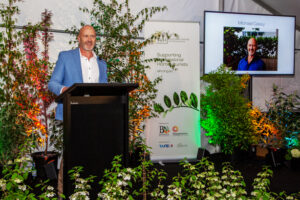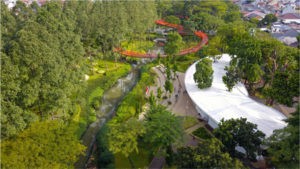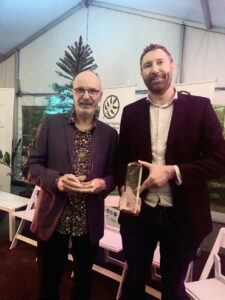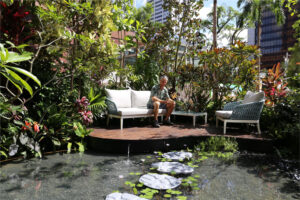
A conference with a difference
By Karen Smith
Melbourne’s Rose Street Artists Market in Fitzroy was a fitting place to host The Australian Institute of Horticulture’s National Day Conference 2022 and Awards night. The hipster venue provided a cosy marquee for the conference with delicious food and a rooftop bar to network in before the awards ceremony proceeded. The event was enjoyable, informative and relaxed.
The focus of the conference was on encouraging fundamental changes to the way horticulturists contribute to addressing societal and environmental issues. There was a mix of expertise in the room ranging from landscape architects, town planners, horticulturists, irrigation and water specialists, arborists and more. This is a very basic overview of the conference and if you couldn’t be there, you missed out on hearing some great speakers, all of whom delivered informative messages of how we can work together to help tackle environmental challenges.

Michael Casey, in his opening address, said that we are all professionals coming from different sectors of horticulture, urban horticulture, design disciplines etc., but where do we sit at the table? Do we sit with labels on or do we work together? Labels seem to govern us when we are all working together to get the same outcome. He had read a comment on LinkedIn from a colleague in Singapore, who said if you want to work seamlessly on a project across professions, you need to remove the titles and listen without prejudice. It seemed to me that many of the people in the room do work together in this way.
Master of Ceremonies Clarence Slockee certainly held the attention of the audience with his very friendly and relaxed manner, particularly when he began the day with a rap song “Everybody say A-I-H…”. Clarence was entertaining and kept the day running smoothly.
The first person to speak was Claire Martin, National President, AILA and a Director of Oculus. Claire spoke about landscape architects’ role in urban horticulture. Claire said since AIH begin over sixty years ago we have moved from the Holocene to the Anthropocene, a period when human activity became a geological force on a planetary scale. 15% of the earth’s land has been degraded by human activity. When 95% of what we eat comes from the soil, soil is precious, disappearing and undervalued. Now more than ever, it is important to communicate the value in what we all do. We can bridge the gap between research, design, cultivation and the maintenance of landscapes.

Gail Hall from Melbourne Water presented on ‘The Healthy Waterways Strategy.’ Working together to meander Melbourne’s waterways from threatened to thriving, Gail said she used the word ‘meander’ deliberately because this healing will take time. We have progressively impacted our waterways for more than two hundred years since colonisation, so it is going to take a while to reverse those impacts. Gail explained that waterways of the region, from the heart of the state of Victoria and the forests of the Yarra Ranges, to the fields of Bacchus Marsh are rivers, creeks and waterways weaving their way through 13,000 km2. The strategy sets a long-term vision for waterway health.
The topic presented by Jason Summers from Remarkable Trees was ‘Trees in the urban environment.’ Jason showed case studies from Toronto, Chicago, Washington and New York as well as local projects. He showed examples of swales and passive irrigation where water is directed toward the plants without the need for pumps, and assisted only by gravity. He discussed the various ways trees can grow in the urban environment and the need for large canopy trees, where space permits, to provide shade, and in return provide energy savings. They offer cleaner air and they store water. The larger the tree the better.

Marc Noyce, Director at Biofilta Pty Ltd, a Melbourne based company, presented on Urban food production. With properties in Australia becoming smaller with larger homes and smaller back yards, people are losing their connection with how food grows. Marc said there is a lot of underutilised space for growing plants, and a lot of underutilised labour. There are a lot of people out there with time on their hands and skills who want to contribute, who could be growing for themselves and their community. Biofilta supplies Foodcubes with wicking beds. They turned a couple of car spaces into a growing area and donate the food grown to Oz Harvest. In twelve months, they grew 467kg of vegetables in just those two spaces. Have a look at their website and look at Melbourne Sky Farm.

Dr Kate Neale from Digability presented on Therapeutic Horticulture. I have heard her speak in the past, and she talks from experience and from the heart. Kate explained what Therapeutic Horticulture involved, as it is a multi-disciplinary field, and that it is a means of connecting with nature through cultivated landscapes to improve general health and wellbeing. Kate is a sociologist and much of her research is about the spaces we create and the ways that we use those spaces that help us in our interpersonal relationships, and the impact it has on our health and wellbeing. Kate spoke of some case studies and it was quite moving. A garden was created in the front of the home of a person with a disability who normally would not have much interaction with neighbours. Neighbours or passers-by would stop to chat to once the garden was installed. The difference it made to that person having the connection with their community was life-changing.
Adam Ferrante, founding member and director of The Rose St Market. Greening streets – where art, nature and social spaces meet. This is a self-funded art initiative based on similar markets based in London, Berlin and New York. The Market showcases 120 creatives weekly and it transformed what was once a junkyard in an area that was once mostly factories. Rose Street now has modern residential dwellings that suit the inner-city lifestyle. Adam took us on a short walk to show the area and explain the design.
Deputy Mayor Cr Nicholas Reece, City of Melbourne, enlightened the audience on the City of Melbourne’s Urban Green Policy. Cr Reece was grateful for the opportunity speak about how we can work together to protect our biodiversity and environment. Cr Reece said that during the pandemic people developed a new appreciation for gardens in their city, with patronage of public gardens increasing by 300%. Plans to ‘green’ Melbourne include increasing their urban forest, tackling their carbon footprint and increasing public open spaces by 2000m2, and are currently opening seven new parks, including a major new park in Docklands. He said they are looking at every space all over the city to see where they can turn grey into green.

Aimee Freimanis, Program Manager for the Gardening Responsibly initiative. The Plant Sure Project aims to develop a voluntary accreditation or certification scheme to engage relevant industries in promoting environmentally safe plants, and removing or avoiding the use of plants that pose an unacceptably high environmental weed risk such as Lantana.

The topic of discussion for Christian Jenkins from Christian Jenkins Design, was designing gardens for mental wellbeing. After doing nine show gardens and losing his father to motor neurone disease, he decided to take a break for a while. When he came back, he connected with Beyond Blue when designing his next four show gardens at the Melbourne International Flower and Garden Show. Christian said when designing a certain garden, whether it be a Japanese garden or a wellness garden, try to draw in different elements. Incorporate natural situations to connect with all the senses. We can all relate to biophilic design to reduce stress and improve our wellbeing, so it is important to incorporate these elements in our designs. Creative, wonderful spaces will enliven people in places such as hospitals, aged care facilities, airports and schools. The act of forest bathing, being emersed in nature, is good for wellbeing and health, and this can be incorporated into designs.
Green infrastructure was the topic of discussion by Pei-Wen Chung from Evergreen Infrastructure. Pei-Wen discussed green facades and green roofs, stating that Australia is one of the most urbanised countries in the world with around 90% of our population living in the major cities, and this has large environmental impacts such as urban heat island effects. Green Infrastructure can help to improve people’s health and wellbeing. With limited space for planting, including greenlife in the built environment has become more popular, with vertical greening using green walls and green facades.
Introducing the awards night, past president Michael Casey said “This year we received a vast number of nominations, with many coming from outside of our membership base which highlights to us the many projects going on around Australia and Singapore that people feel should be acknowledged and recognised. The AIH wishes to congratulate all nominees and recipients of awards for 2022 and wishes everyone the best for their projects and future endeavours”.
The awards night was MC’d by another entertaining industry character, Costa Georgiadis, who presented the following awards.
The award winners were:
Golden Wattle – Christian Jenkins
For commitment, versatility & dedication to Horticulture
Silver Gum – Michael Casey
For promotion and contribution to the Australian Horticultural Industry
Fellowships 2022 – Wayne Van Balen FAIH
Horticulturist of the Year 2022 – Daniel Austin
AIH Horticultural Student of the Year 2022 – Nathan Watson
Kim Morris Student Award of Merit 2022 – Jasmine Gunnoo
Green Space Urban Award – Melbourne Sky Farm Project
Green Space Events Award – Gardens for Wildlife Victoria
Green Space Regional Award – Sawtell Catholic Care
Green Space Residential Award – Scapex Landscapes
Primrose Terrace Project, Red Hill QLD
Green Space International Award – Siura Studio
Tebet Eco Park, South Jakarta
Award of Excellence – Stephen Whitteridge MAIH RH
Award of Excellence – Prestigious Gardens
Clifton Street Project, Malvern SA
Award of Merit – Denis Crawford
Award of Merit – Melbourne Bushfoods
Award of Merit – Charlie Albone
Main photo: Green Space Urban Award – Melbourne Sky Farm Project (Image: Melbourne Sky Farm)
